What grain is millet made from and why is it needed?
When buying products, you want to know what they are made of. Among cereals for cooking porridges - side dishes common throughout the world - there is a pattern in the names. And you don’t have to be an expert to understand what kind of cereal comes from. Buckwheat is made from buckwheat, barley is made from barley, and rice is made from rice.
What is millet made from? Among the cereals there is no suitable name. It is worth understanding what became the raw material for the production of the familiar sunny yellow porridge in order to understand what properties this product has, what benefits it brings and what dangers it hides.
Chemical composition of millet cereals
Millet contains beneficial nutrients. Their content per 100 g of dry cereal is given in the table below.
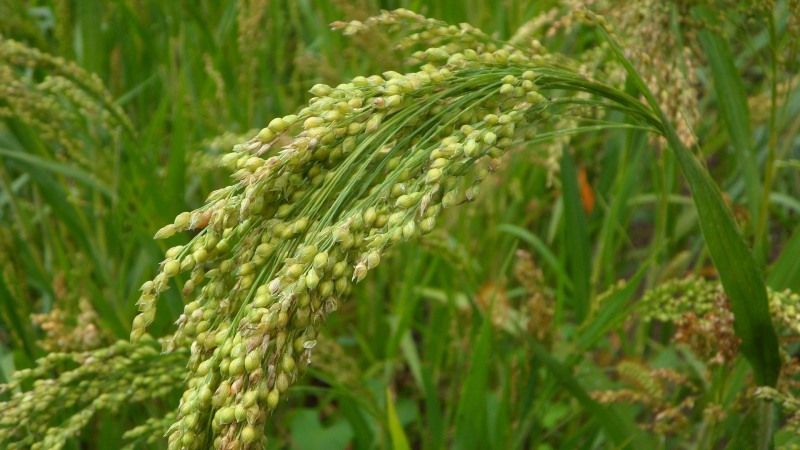
| Biologically active substance | Quantitative content in 100 g of dry millet | % of recommended daily intake |
| Beta carotene | 20 mcg | — |
| Vitamin E (alpha tocopherol) | 0.3 mg | 2% |
| Vitamin B1 (thiamine) | 0.42 mg | 28% |
| Vitamin B2 (riboflavin) | 0.04 mg | 2% |
| Vitamin B6 (pyridoxine) | 0.52 mg | 26% |
| Vitamin B9 (folate) | 40 mcg | 10% |
| Vitamin PP (niacin) | 6.2 mg | 31% |
| Potassium | 211 mg | 8% |
| Calcium | 27 mg | 3% |
| Magnesium | 83 mg | 21% |
| Sodium | 10 mg | 1% |
| Sulfur | 77 mg | – |
| Phosphorus | 233 mg | 29% |
| Chlorine | 24 mg | 1% |
| Iron | 2.7 mg | 15% |
| Iodine | 4.5 mcg | 3% |
| Cobalt | 8.3 mcg | 83% |
| Manganese | 0.93 mg | 47% |
| Copper | 0.37 mg | 37% |
| Molybdenum | 18.5 mcg | 26% |
| Fluorine | 28 mcg | 1% |
| Chromium | 2.4 mcg | 5% |
| Zinc | 1.68 mg | 14% |
100 g of dry millet contains 348 kcal. Loose millet porridge contains 135 kcal per 100 g of product, which is 6.71% of the average daily calorie intake for an adult.One serving of millet porridge is 250 g, it replenishes the body's daily energy needs by 17%.
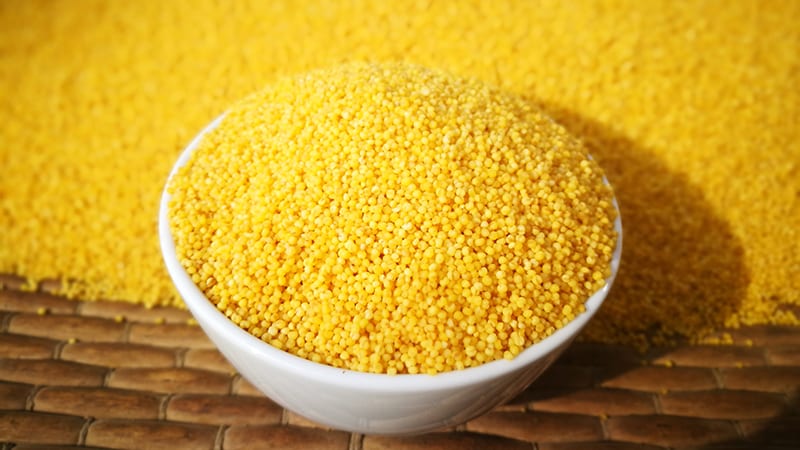
Nutrient content per 100 g of dry cereal:
- carbohydrates – 66.5 g;
- fats – 3.3 g;
- proteins – 11.5 g;
- dietary fiber – 3.6 g;
- water – 14 g;
- mineral salts – 1.1 g.
100 g of crumbly millet porridge without oil and sugar contains 4.7 g protein, 1.1 g fat and 26.1 g carbohydrates.
For reference. The high content of nutrients, varied mineral composition and low calorie content make it possible to include millet in the list of dietary products.
What grain is millet made from?
Having asked the question of what grain millet is made from, we find the answer: millet is obtained from the fruits of cultivated millet species.
Interesting! Millet (lat. Panicum) is a herbaceous plant of the Cereals family. Eight species of this cereal grow in Russia and the CIS countries. Millet groats are made primarily from millet.
Why is millet cereal not called millet cereal? The word “millet” itself comes from the Slovenian word “pšénọ”, meaning “hulled grain”. From this name you can guess that before millet grains turn into millet, they need to be cleaned and processed.
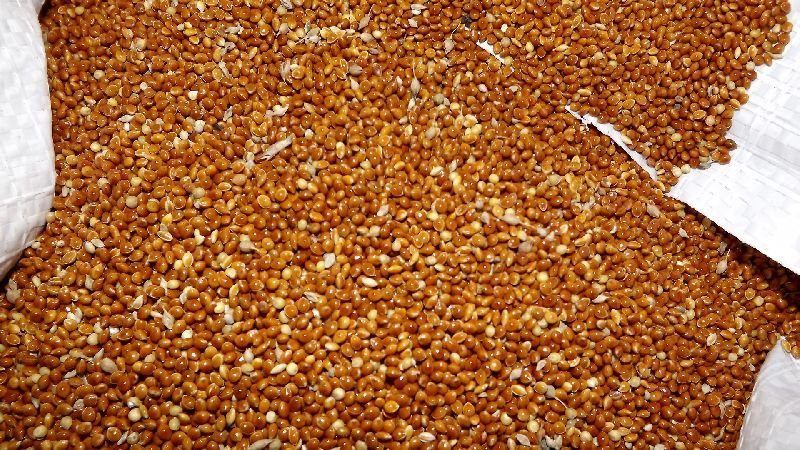
Millet cereal production technology
If you just collect millet grains, you won’t get millet. So what is millet and what grain is it made from? To obtain a boiled, easily digestible product, millet grains are processed in several stages.
To turn millet unrefined cereal into millet, first of all, the collected grains are subjected to selection. Large grains of light brown color without visible signs of spoilage are selected for further processing. At this stage, weed seeds, pebbles and sand are also sifted out.
The grains are then hulled, separating the kernels from the millet husks. This process occurs in rolling deck machines.
After this, it is necessary to peel off the aleurone layer - the outer film shell - from the nuclei. This procedure is called grinding and occurs in grinding or screw press equipment.
When receiving premium grade millet Before packaging, the grains are washed in a stream of hot steam to remove process oils that clog the pores of the grains during grinding in contact with equipment. Technical oils give the finished cereal a bitter taste, which reduces the consumer properties of the product.
Interesting facts about cereals:
What is millet, how does it grow and where is it used?
Types of millet cereals
Millet is not always fully processed. The more technological stages millet grains have gone through before reaching store shelves, the better and more expensive the millet grains are.
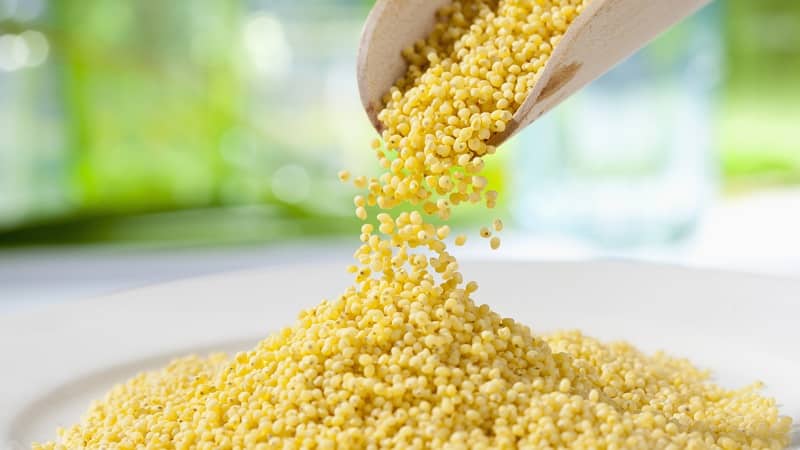
Types of millet:
- Dranets. This grain is obtained after exfoliation of the rough shell. The result is whole, shiny grains with a bitter aftertaste. Millet porridge takes a long time to cook.
- Polished millet. Goes through all technological stages. The finished product looks like solid yellow matte grains. Polished millet cooks faster than millet-dranet.
- Crushed millet. This is a by-product of millet cereal production, consisting of coarse millet kernels crushed during the grinding process. Crushed millet is added to whole grain bread or further ground to produce millet flour.
- Millet flakes.This is the most expensive millet product, as it goes through all stages of processing, including primary cooking and vacuum drying. Millet flakes are included in instant porridges.
Despite differences in processing, Each type of cereal has properties beneficial to the human body..
Useful properties of millet
The diverse chemical composition determines variety of beneficial properties of millet for the body:
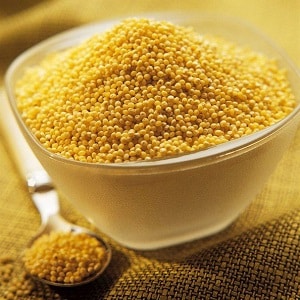 Millet dietary fiber adsorbs excess fat in the intestines and removes it, thereby reducing the amount of fat consumed in food, including cholesterol. Millet is useful for atherosclerosis and obesity.
Millet dietary fiber adsorbs excess fat in the intestines and removes it, thereby reducing the amount of fat consumed in food, including cholesterol. Millet is useful for atherosclerosis and obesity.- The zinc and manganese contained in millet serve as coenzymes in the synthesis of insulin. Despite the high carbohydrate content, the glycemic index of millet porridge without sugar is 40 units. This indicator allows you to include millet porridge in the diet of diabetics in moderation.
- The high content of B vitamins has a beneficial effect on the state of the nervous and cardiovascular systems.
- Folic acid salts, iron, copper and cobalt stimulate hematopoiesis, which is useful for the prevention of anemia.
- The rich amino acid composition and a large number of coenzyme minerals help restore the liver after intoxication loads. A thick decoction of millet cereal restores the barrier function of the liver after alcohol poisoning and treatment with antibiotics and chemotherapy drugs.
- Silicon, copper, fluorine and phosphorus strengthen bone tissue and tooth enamel, stimulate hair and nail growth, and maintain the elasticity and strength of blood vessels.
- Chromium and iodine support thyroid function.
- Molybdenum and vitamin E prevent the accumulation of free radicals, keeping the body youthful.
The positive effect of millet on the body allows this cereal to be used in folk medicine. Dietitians include millet porridge in the diet of patients with dysfunction liver, kidneys, pancreas, diabetes, obesity, atherosclerosis and other metabolic pathologies.
Read also:
How to make malt from barley at home
The benefits and harms of coffee drink made from barley and rye
Restrictions on the consumption of millet products
Despite the many positive effects from taking millet, like any product, millet has its contraindications and limitations in use. Millet is not a panacea and requires moderation.
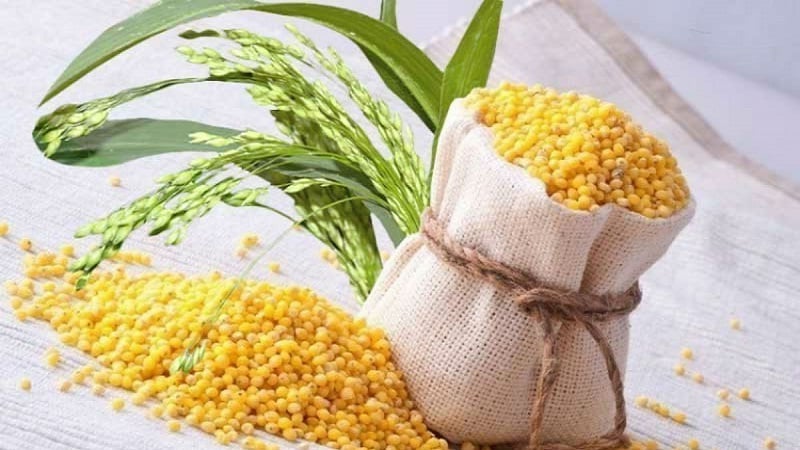
Precautionary measures:
- During pregnancy, you should limit your intake of millet and consume it only as needed by the body, no more than 1 serving. A high content of mineral biologically active components can unbalance the process of fetal tissue formation, and in the last trimester, excessive consumption of millet can provoke premature birth.
- If you have inflammatory bowel diseases, you should limit your consumption of millet products, as millet can cause constipation and aggravate inflammation. This restriction applies only to millet and polished millet. Millet flakes contain less coarse fiber, which injures the inflamed intestinal mucosa.
- Millet reduces the acidity of gastric contents, so it should be consumed in moderation for gastritis with low acidity.
- When taking iodine supplements, for example, in the treatment of hypothyroidism, millet should be excluded from the diet so that a constant dosage of the microelement entering the blood is maintained.
If you follow the recommendations of doctors and restrictions, products made from millet cereals will not harm the body. It should be remembered that millet is a food product, not a medicine. It can alleviate the patient’s condition, but the doctor prescribes therapeutic measures for complete recovery.
Conclusion
Millet, familiar to everyone, is purified millet grains. The word “millet” came into Russian from the Slovenian language, in which it was used to refer to any purified grain. Several types of millet are produced in production, differing in the quality of purification of the raw materials. The highest quality types of millet cereals are millet flakes and millet millet.
All types of millet cereals have beneficial properties and a rich composition of nutrients that support the health of the body. You should not consume millet products in excess during pregnancy, intestinal inflammation, gastritis with low acidity, and when taking iodine-containing medications together.
Thank you, interesting and useful. =)